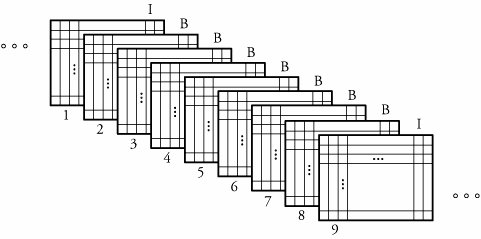Section 17.4. Moving Images and MPEG Compression
17.4. Moving Images and MPEG CompressionA motion image , or video is a rapid display of still images. Moving from one image to another must be fast enough to fool the human eye. There are different standards on the number of still images comprising a video clip. One common standard produces a motion image by displaying still images at a rate of 30 frames per second. The common standard that defines the video compression is the Moving Pictures Expert Group (MPEG), which has several branch standards:
Logically, using JPEG compression for each still picture does not provide sufficient compression for video as it occupies a large bandwidth. MPEG deploys additional compression. Normally, the difference between two consecutive frames is small. With MPEG, a base frame is sent first, and successive frames are encoded by computing the differences. The receiver can reconstruct frames based on the first base frame and the submitted differences. However, frames of a completely new scene in a video may not be compressed this way, as the difference between the two scenes is substantial. Depending on the relative position of a frame in a sequence, it can be compressed through one of the following types of frames:
Figure 17.9 illustrates a typical grouping of frames, with I, P, and B frames forming a sequence. In any frame sequence, I frames appear periodically as the base of the scene. Normally, there is a P frame between each two groups of B frames. Figure 17.9. Snapshot of moving frames for MPEG compression 17.4.1. MP3 and Streaming AudioSection 17.2 explained how an audible sound or a human voice ranging between 20 Hz and 20 KHz can be converted into digital bits and eventually into packets for networking. A signal is sampled, quantized, and encoded, a process called PCM. A variety of methods of compressing such encoded products at the output of the PCM are available. However, Huffman compression of the processed signal may not be sufficient for transmission over IP networks. The MPEG-1 layer 3 (MP3) technology compresses audio for networking and producing CD-quality sound. The sampling part of PCM is performed at a rate of 44.1 KHz to cover the maximum of 20 KHz of audible signals. Using the commonly used 16-bit encoding for each sample, the maximum total bits required for audio is 16 x 44.1 = 700 kilobits and 1.4 megabits for two channels if the sound is processed in a stereo fashion. For example a 60-minute CD (3,600 seconds) requires about 1.4 x 3,600 = 5,040 megabits, or 630 megabytes. This amount may be acceptable for recording on a CD but is considered extremely large for networking, and thus a carefully designed compression technique is needed. MP3 combines the advantages of MPEG with "three" layers of audio compressions. MP3 removes from a piece of sound all portions that an average ear may not be able to hear, such as weak background sounds. On any audio streaming, MP3 specifies what humans are not able to hear, removes those components , and digitizes the remaining. By filtering some part of an audio signal, the quality of compressed MP3 is obviously degraded to lower than the original one. Nonetheless, the compression achievement of this technology is remarkable . |
EAN: 2147483647
Pages: 211
